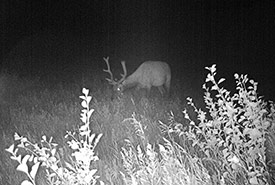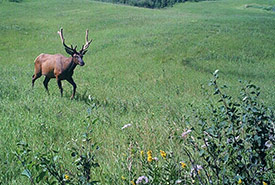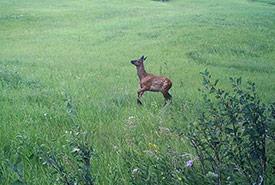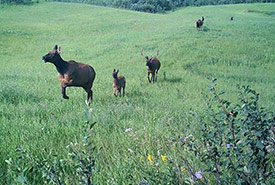Adventures in elk country: Exploring conservation, wildlife and nature

Elk at Lockerby, AB (Photo by NCC)
As the Nature Conservancy of Canada’s (NCC’s) conservation intern in the Red Deer River this past summer, I assisted in monitoring more than 35 properties in central Alberta. A critical aspect of monitoring involves making species observations, particularly of keystone species such as elk. This not only helps NCC track the health of the ecosystem but also provides valuable insights into how these pivotal species are faring. Using this information, we can make informed conservation decisions to ensure the species’ continued resilience and stability.

Elk is an important indicator species in an ecosystem (Photo by NCC)
Located near Pine Lake, the Lockerby property is a diverse landscape, featuring a blend of woodlands, wetlands and a hayfield. We set up a trail camera by the hayfield for two months to monitor the wildlife. During this time, it captured a multitude of sightings, including numerous deer and coyotes, as well as several moose. Most notably, though, the camera recorded over 17 elk sightings, including the presence of four calves. The largest elk herd observed consisted of three cows, two bulls and two calves, a heartening sign of their well-being. It's particularly exciting to witness the presence of elk calves, as it signifies they’re thriving in this natural habitat.
Elk play a vital role in maintaining the health and balance of ecosystems. Their influence on the landscape is profound, contributing significantly to biodiversity. By consuming a wide range of plant species, elk help prevent the dominance of specific plants such as Kentucky bluegrass and smooth brome, allowing for a diverse array of vegetation to flourish. This benefits other wildlife species that rely on varied vegetation for food and habitat.

Elk fawn at Lockerby, AB (Photo by NCC)
Calves are a captivating and vulnerable part of the elk population. Born in the spring, they have distinct reddish-brown coats with white spots, providing them with excellent camouflage in their forested habitats. They rely on their mothers for nourishment and protection during their first few weeks of life, learning essential survival skills like grazing, navigating the terrain and recognizing potential threats. Elk calves are incredibly agile, capable of standing and walking within hours of birth.
Elk are a valuable indicator species in ecosystems due to their sensitivity to environmental changes. Elk populations respond to alterations in habitat quality, climate conditions and resource availability. Observing shifts in elk distribution, foraging patterns and migration behaviours often offers valuable insights into broader ecological trends. When elk populations decline or their distribution changes significantly, it can serve as an early warning sign of ecological imbalances and deteriorating environmental conditions. Focusing on elk as indicator species helps protect them and alerts us to ecosystem issues, aiding conservation and habitat preservation.

Elk herd sighted on the Lockerby property, AB (Photo by NCC)
Elk face an array of challenges, from human encroachment to natural environmental factors. Habitat loss and fragmentation are significant threats, driven by urban development and agriculture, which reduce the available space for the species to roam, find adequate food and shelter, and maintain their traditional migration routes. Human activities, including hunting and road collisions, also present additional risks to elk survival. Predation by apex predators, such as wolves, bears and cougars, pose a constant threat, especially during their early lives. These challenges jeopardize elk populations, making their conservation crucial to ensure the continued presence of these herbivores in North America. The continuous land conservation efforts by NCC enable elk to locate suitable habitat and food resources, lessening the challenges that they face and benefiting the entire ecosystem.
My experience as an intern with NCC has significantly increased my connection with nature. Getting to spend so much time in nature has been a dream come true for me. My understanding of plants, animals and conservation has greatly expanded. This journey has reinforced my belief that the work carried out by NCC is significant to conservation. The organization's efforts genuinely create a meaningful and lasting impact on the protection of our environment.
NCC’s Internship Program in Alberta is supported by United Nations Association in Canada’s Science and Technology Internship Programme.


